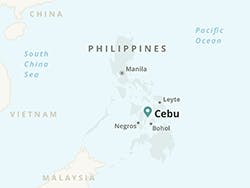About LMPC

Lamac Multi-Purpose Co-operative was set-up in 1973 by 70 small-scale farmers from the Lamac village (a small village in the mountains of central Cebu). The cooperative was started with the support of the Department of Local Government and Community Development (DLGCD) to provide consumer and marketing services for its members. In its early years, the cooperative worked with the DLGCD to implement vital infrastructure and services (such as electricity and potable water) to this isolated and poor community. A predominantly agricultural community, over the years the cooperative received growing demand from local farmers for access to credit to ensure increased productivity on their farms. However, it was not until 1992 when LMPC was able to offer its first line of credit to its members. Starting with just $500 shared between 40 farmers, LMPC has since grown (with the help of the Land Bank of the Philippines) to an operation of 26 branches (throughout the province of Cebu with a small presence on the islands of Leyte, Bohol and Negros) with over seventy thousand savers.
What is LMPC’s mission?
LMPC’s mission is to respond holistically to the needs of vulnerable sectors of society through socio-economic programmes. Members of the cooperative are not only entitled to access capital, they are also provided with extensive financial and non-financial training and supported in market linkages. Committed to its origins, LMPC’s target members are farmers and within this group, the Cooperative particularly targets women, youth, and people with disabilities.
What types of financial services does LMPC provide?
Primarily, it provides micro-loans, insurance, and savings facilities to its members. Loans range from US$1,000 or less for groups of women who wish to start very small-scale income-generating projects to loans for SMEs and social businesses. In addition to enterprise loans, LMPC offers credit for consumption and agriculture. Most members (excluding the very poorest) are obliged to pay a minimum annual membership fee of approximately US$5 a year and are encouraged to save each month. Borrowers are expected to save approximately US$1 a month during the length of the loan term and earn interest on these savings. LMPC share any profits with their members in accordance to their share capital.
How much interest does LMPC charge?
Microfinance institutions (MFIs) charge higher rates of interest for several reasons. Firstly, the administrative costs of making many small loans are much higher than making fewer larger loans; secondly, they take more time assessing the feasibility of applications and thereby reducing risk because borrowers cannot offer traditional forms of collateral nor do they have salaried incomes; thirdly MFIs often operate in geographically remote areas with low population densities and this means that they incur greater operational costs; and fourthly they often accompany loans with a range of training and technical advice. In addition, inflation is generally higher than in countries such as the UK.
The most representative loan product of LMPC funded by Lendwithcare attracts an Annual Percentage Rate (APR)* of 21.3%.
*The Annual Percentage Rate (APR) is a standard way of expressing the cost of a loan that allows for comparison between loans. It includes annual interest, insurance, and fees that the borrower must pay, and it is expressed as a percentage of the amount borrowed.
Does LMPC provide any training?
Yes, it provides extensive training in addition to running a number of community outreach programmes that are available to its members. Training and programmes such as:
- Financial literacy and marketing training
- Business development and market linkages support
- Training on crop diversity and sustainable farming methods
- Training on savings and cooperative ethics
- Promoting gender equality among cooperatives in the Philippines
- Community sessions on maternal health and water and sanitation
- The cooperative youth groups
- Disaster relief and preparedness
Where can I find out more information about LMPC?
Further information about LMPC is available from the organisation's website here.
LMPC: Basic facts and figures (March 2025)
Full name: | Lamac Multi-Purpose Cooperative (LMPC) |
Established: | 1970 (started disbursing loans in 1992) |
Average loan size: | US$845 |
Number of active loans: | 87,529 |
Outstanding loan portfolio: | US$47,726,911 |
Portfolio at Risk (PAR) at 30 days*: | 8.5% |
Proportion of members who are women: | 72% |
Proportion of loans given in rural areas: | 78% |
*PAR30 is a commonly used metric that provides an insight into the quality of an MFI's loan portfolio, which is generally its major asset and therefore its greatest source of risk. It is computed by dividing the amount of delinquent loans greater than 30 days over the total amount of the loan portfolio.
Philippines: Basic facts and figures (August 2025)
Population: | 116 million* |
Currency: | Philippine peso* |
GDP per capita: | US$3,985* (compared with US$52,637 in the UK) |
Inflation (GDP deflator): | 3.2%* |
Life expectancy: | 70 years* |
Percentage of population living on less than $3.00 a day: | 5.3%* |
Human Development Index ranking: | 117 (of 193 countries)** |
Population using safely managed drinking water: | 48%*** |
Infant mortality rate (per 1,000 live births): | 22**** (compared with 4 in the UK) |
Percentage of adults with a bank account: | 56%**** |

We're proud to introduce a new way to support low-income families most at risk of climate change through Lendwithcare. Find out more about making a grant today.